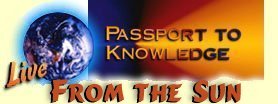

|
LIVE FROM THE SUN featured the latest discoveries about our local star, the ultimate source of all life on Earth. The Module continued in the 1999-2000 school year as LIVE FROM THE SUN 2000 with an all new broadcast which aired on November 16, 1999, opportunities to interact with solar researchers, and updated Web materials through Solar Maximum, expected to peak in 2000-2001. The LIVE FROM THE SUN/LIVE FROM THE SUN
2000 Teacher's Guide and MultiMedia Kit are available along with copies of
all three broadcasts. |
The Teacher's Guide, videos and online resources are organized under 4 themes: * THE SUN AS A STAR * HOW THE SUN WORKS * THE SUN-EARTH CONNECTION, and * THE SUN IN HUMAN HISTORY AND CULTURE |
|
Veteran P2K teachers who are consulting on the development of the instructional support materials estimate that solar science touches on some 30-40% of the entire middle school science curriculum, and will relate closely to many aspects of Earth, Life and Physical science, as well as to Space science and astronomy.
|
|
|
|
Program 1 "Our Sun In Close Up" Without the Sun, there would be no life on the surface of Earth. This program provides a comprehensive update on the amazing discoveries of the past decade, during which NASA spacecraft have returned astonishingly detailed views of the only star we can see... "in close up." But our Sun helps us understand all the other stars out there in the Universe beyond our solar system. In addition to seeing the Sun in close-up, viewers will go behind the scenes at NASA's Goddard Space Flight Center, Greenbelt, MD--Sun Central/Mission Control for many of America's solar spacecraft, and Lockheed Martin Solar and Astrophysics Laboratory, Palo Alto, CA where some of the most powerful telescopes on board recent spacecraft have been built and tested. Program 2 "Solar Studies and Sunny Interactions" Originally broadcast live from NASA's Goddard Spaceflight Center, solar researchers explain the "colors" of the Sun and how the Doppler effect reveals the Sun's internal structure, and much more! See how a blowtorch can make a household tile glow orange--and how color is a clue to temperature. Goddard astrophysicists join in a tuneful and scientifically accurate 'a capella' tribute to our Sun. See how and why solar science is so exciting for the men and women who study our star with spacecraft and telescopes. Program 3 "To the Max" "To The Max" visits NASA's Goddard Space Flight Center (Greenbelt, MD) and Marshall Space Flight Center (Huntsville, AL) to update viewers on changes in solar behavior as Solar Maximum approaches. Find out how to "follow the Sun" throughout the coming year via hands-on activities such as building horizon calendars and special "noon shadow" projects, and also via the Internet. |
System Requirements
|
|
|
|
|
LIVE FROM THE SUN/LIVE FROM THE SUN 2000 is principally supported
by
NASA, the National Aeronautics and Space Administration,
with additional collaboration from the National Oceanic and Atmospheric
Administration, NOAA,
NSF's NOAO/AURA, and other public and private partners.